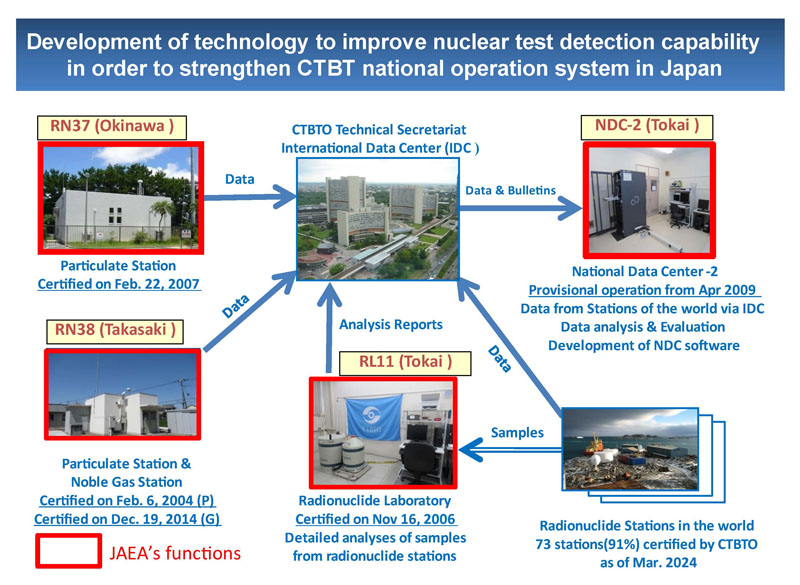Technology Development and Contribution to CTBT
Development of nuclear nonproliferation and nuclear security technologies
Nuclear Forensics
Nuclear forensics in the context of nuclear security is a technical means to support criminal investigations by analyzing the origins, history, transportation routes and intended use of materials out of regulatory control and related evidences seized by law enforcement, based on the measurement of their physical and chemical characteristics such as material compositions. We are working on the development of analytical capabilities necessary for nuclear forensics analysis, nuclear forensics library including nuclear and radioactive material databases; and building radiation measurement technology to support first response at the crime scene by law enforcement.
Nuclear Forensics
Process

- Sample Measurement Technique
- Isotope Ratios
- Trace Element Compositions
- Uranium Chronometry
- Morphology Analysis
- Nuclear Forensics Library
- Database (Nuclear/Radioactive Material)
- Data Analysis Approach, Tools
- Machine Learning Model Applications
- Radiation Measurement Technology for First Responders
- Handheld Radioisotope Identification Device
- Direction-sensitive Gamma Detector
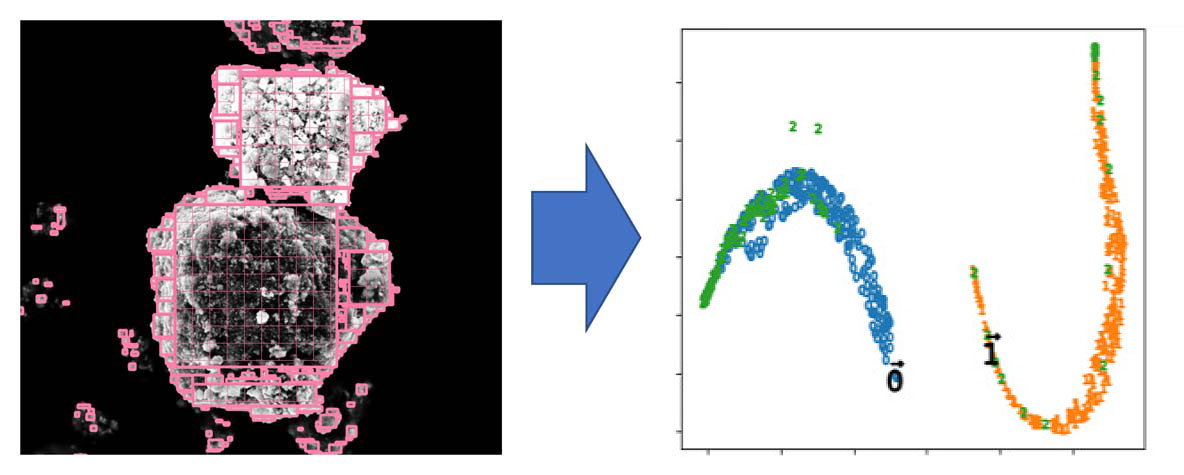
Surface Pattern Analysis of Nuclear Materials
by Deep Learning Model
Active Neutron Technology
Non-Destructive Assays (NDAs) are classified into passive and active methods. The passive method measures neutrons and gamma rays spontaneously emitted from a sample. However, when measuring high-radioactivity samples (spent fuel) with a strong gamma-rays and neutrons passive radiation due to fission products and minor actinides, the fissile signature is hidden, and they are difficult to measure passively. Active methods use an external source of neutrons to induce nuclear reactions in the sample. The radiation generated is measured, and if it is significantly higher than the passive background, it can be applied to sample measurement.
Neutron Resonance Analysis
Neutron Resonance Analysis (NRA) combines three different techniques to quantify the fissile nuclides content:
- Neutron Resonance Transmission Analysis (NRTA) - transmitted neutrons are measured downstream
- Neutron Resonance Capture Analysis (NRCA) - prompt gamma rays are measured at the sample position
- Neutron Resonance Fission Neutron Analysis (NRFNA) - fission neutrons are measured at the sample position
In experiments conducted at the KURNS-LINAC of Kyoto University, the fission resonance peaks of U-235 were observed under various conditions. We are in the process of proving the feasibility of NRFNA system. In the future, we aim to apply it to IAEA safeguards for nuclear material's quantification.

Diagram of the NRA measuring system
Delayed Gamma-ray Spectrometry
Delayed Gamma-ray Spectrometry (DGS) is a nondestructive assay technique that can be used for nuclear safeguards verification by quickly evaluating the fissile nuclide content in pure or mixed nuclear materials, especially high-radioactivity nuclear material. A DGS interrogation uses neutrons to induce fission in the sample and the gamma rays from the decaying fission products are observed over multiple cycles to determine U/Pu mass and composition. We are developing the analytical capabilities and associated instrumentation for reprocessing plant near-term applications and full assembly long-term goals.
- Spectral Analysis Development
- Rodriguez et al., J. Nucl. Sci. and Technology 57 (8), 2020, 975-988
- Rossi et al., Nucl. Inst. and Methods 977, 2020, 164306
- Rodriguez et al., Nucl. Inst. and Methods 997, 2021, 165146
- Tohamy et al., Applied Radiation and Isotopes 173, 2021, 109694
- Rodriguez et al., Transactions on Nucl. Science 71 (3), 2024, 255-268
- Instrumentation Development
- Rodriguez et al., Applied Radiation and Isotopes 148, 2019, 114-125
- Rossi et al., J. Nucl. Sci. and Technology 58 (3), 2021, 302-314
- Rodriguez et al, Nucl. Inst. and Methods 1014, 2021, 165685
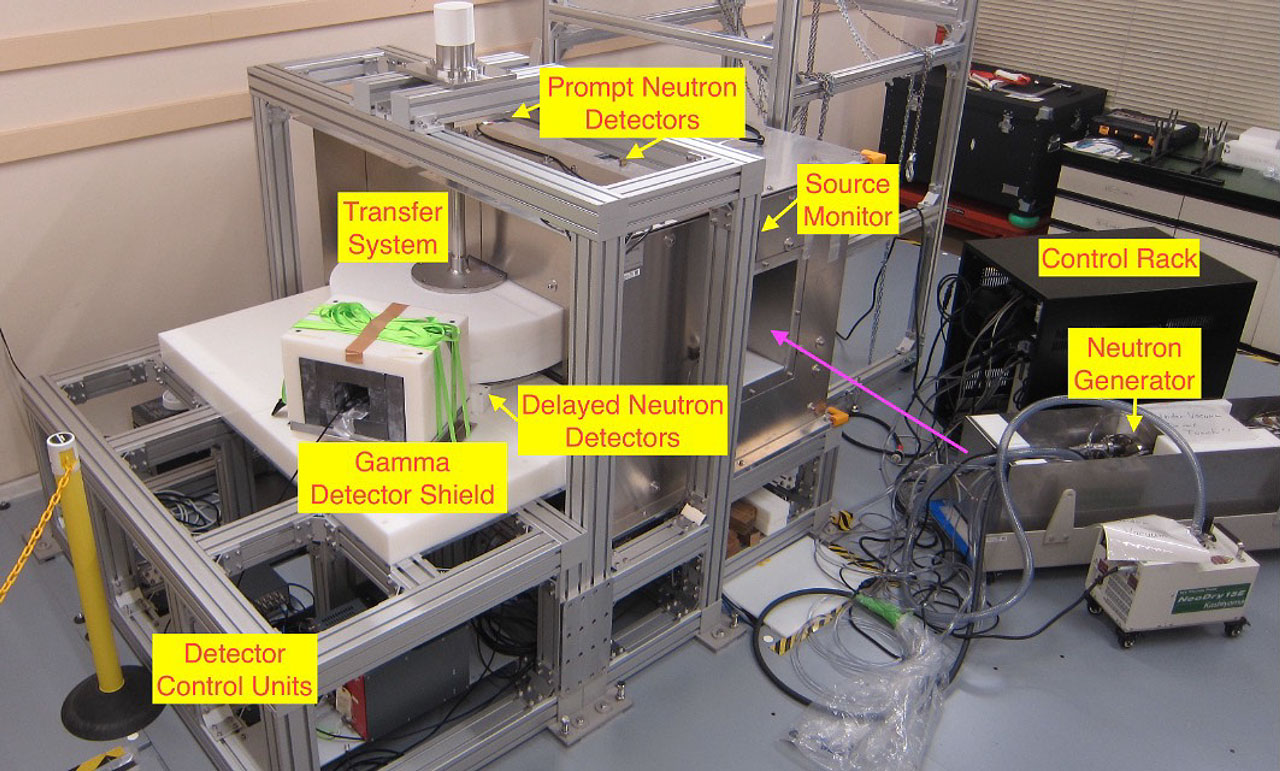
The Fission Signature Assay Instrument designed to apply DGS and neutron analysis to small NM samples
Wide Area Monitoring
The development of technology for detecting nuclear and radioactive materials over wide areas has been underway since 2020. This project aims to create devices and systems capable of efficiently detecting nuclear and radioactive materials over a wide area inside and around large public events, such as sports games and concerts, as well as large commercial facilities.
To create systems applicable in various scenarios, remote measurement technologies including automatic running robot will be introduced.
- Radiation mapping systems
- Remote measurement through LPWA network
- 2D/3D SLAM using LiDAR and IMU
- Techniques for radiation source localization
- Mobile gamma-ray detector
- Direction sensitive fast neutron detectors
- LPWA: Low Power Wide Area
- SLAM: Simultaneous Localization and Mapping
- LiDAR: Light Detection and Ranging
- IMU: Inertial Measurement Unit
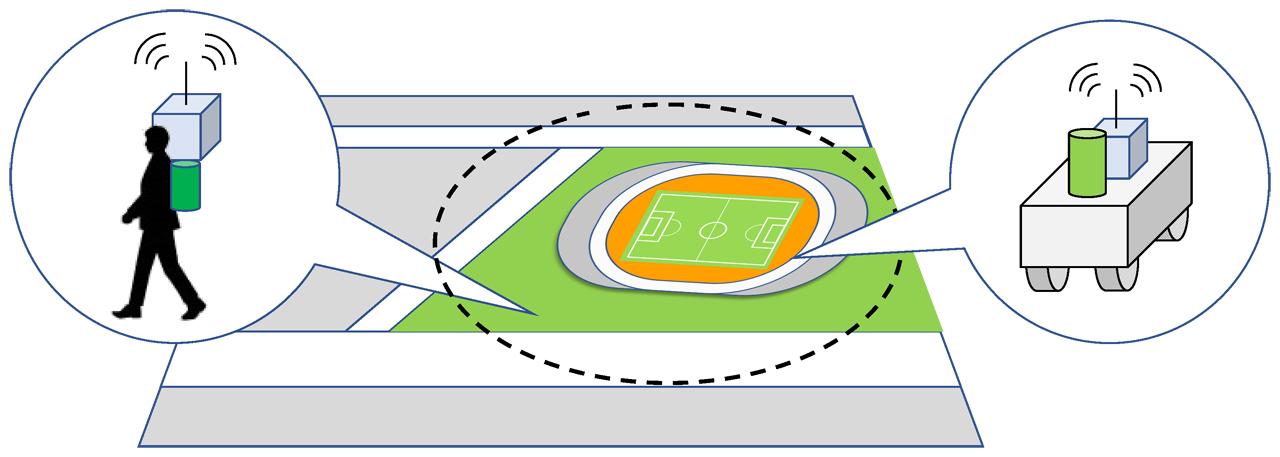
Concept of wide area monitoring around the stadium
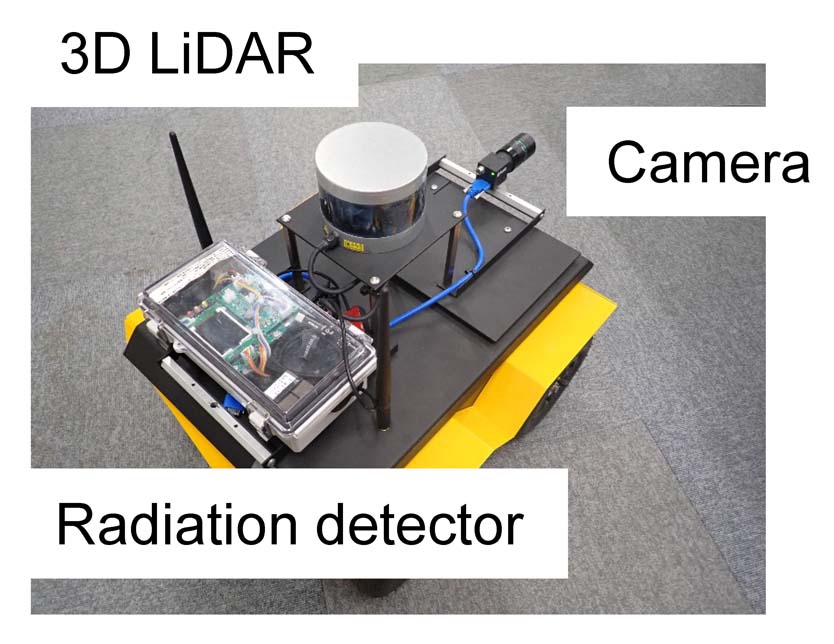
Crawler robot equipped with a radiation detector

Concept of wide area monitoring around the stadium
Nuclear Resonance Fluorescence
Nuclear Resonance Fluorescence (NRF) is an active nondestructive technique that is capable of identification of isotopes even they are shielded with considerably heavy materials, thanks to the high energy of the involved gamma-rays. NRF utilizes the excitation of the energy levels of nuclei and measurement of the subsequent de-excitations. Thus, NRF provides unique signature of each isotope. The NRF method is best matched with the laser Compton gamma-ray sources (LCS), since these sources provide lower background and tunability in the gamma-ray energy. ISCN is developing nondestructive assay scheme based on LCS driven NRF. For example, the lead isotope Pb-208 could be nondestructively identified using the resonance level at 7.3 MeV.
Not only qualitative identification, but also, NRF can in principle, give a complete isotopic analysis. For further details, please take a look on our recent publication (Nondestructive determination of isotopic abundance using multi-energy nuclear resonance fluorescence driven by laser Compton scattering source).
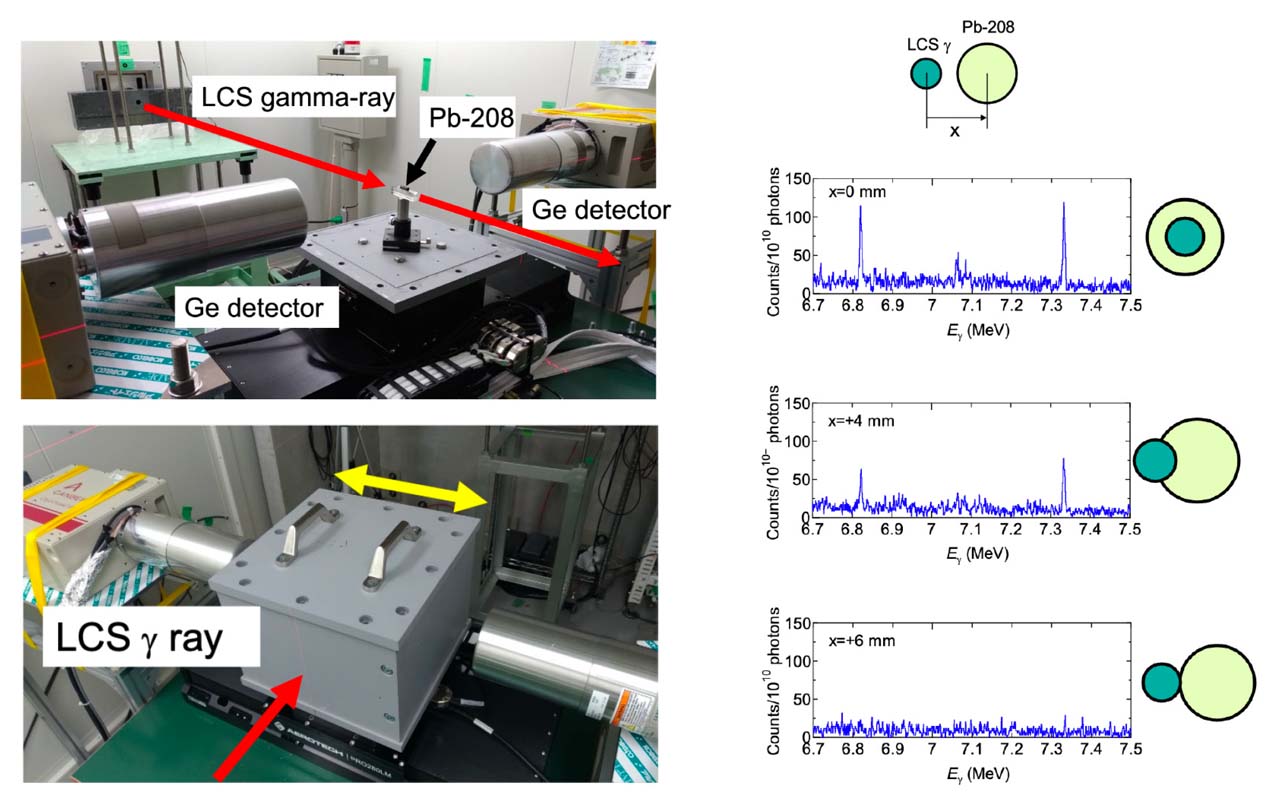
Demonstration of nondestructive identification of Pb-208 isotope shielded in 1 cm iron box. NRF peaks appear only when the gamma-ray hit the isotope of interest. This demonstration experiment has been conducted in the gamma-ray beam line of the New SUBARU facility, University of Hyogo,
Technology development conducted in the past
- NDA for plutonium in spent fuel
- Alternative neutron detectors for helium-3
- Neutron resonance densitometry
- Advanced plutonium monitoring technology
- Nuclear material accounting and control technology for fuel debris from Fukushima Daiichi nuclear power plant
- Safeguards application research of satellite information
- Research on transparency in nuclear nonproliferation
- Integrated NDA system: Active-N
- Safeguards technology development for direct disposal of spent nuclear fuel
- Laser-Driven Neutron Source
Other activities
CTBT
Scheme of CTBT International Verification Regime
The Comprehensive Nuclear-Test-Ban Treaty (CTBT) prohibits any nuclear weapon test explosion or any other nuclear explosion in all spaces, including cosmic space, the atmosphere, underwater, and underground, and prescribes the establishment of a verification regime to ensure that each member state adheres to the treaty.
Although the CTBT has been ratified by 178 countries, it has not yet been enforced because it has not been ratified by the countries that are required to enable its operationalization. However, in preparation for the future implementation of the Treaty, 90.2%* (304/337) of the four types of International Monitoring System (IMS) facilities (seismic, radionuclide, hydroacoustic and infrasound) established for the detection of nuclear tests, as defined in the Protocol of the Treaty, have been installed, certified, and operated across the world.
* as of March 2024
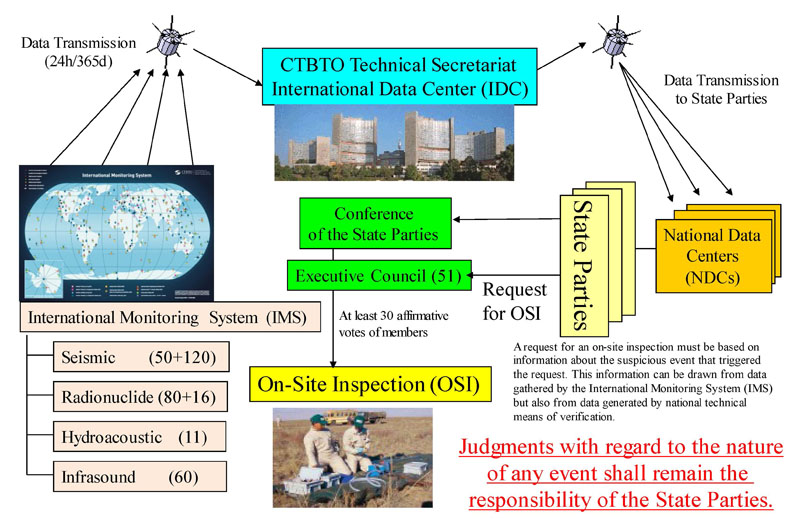
- (1) 187 signatories and 178 ratified countries
- (2) Of the 44 countries required for enforcement, 41 signatories and 35 ratifying countries
Of the 44 countries required for enforcement,
Signed / unratified countries (6 countries): USA, China, Egypt, Iran, Israel, and Russia
Unsigned / unratified countries (3 countries): North Korea, India, and Pakistan
ISCN's Contribution to the International CTBT Verification Regime
JAEA has completed the construction of the Okinawa and Takasaki radionuclide stations, and the Tokai Radionuclide Laboratory, which have been certified by the CTBT Organization (CTBTO) as facilities satisfying the technical requirements for nuclear test monitoring and have been in operation. In addition, the National Data Center (NDC-2) receives radionuclide station data from the International Data Center (IDC) in Vienna, Austria, and analyzes these data on a daily basis. The Okinawa station is located in the Okinawa Tracking and Communication Station of the Japan Aerospace Exploration Agency, and the Takasaki station is located in the Takasaki Advanced Radiation Research Institute of the National Institutes for Quantum Science and Technology. The Tokai Radionuclide Laboratory and NDC-2 are located in the Nuclear Science Research Institute of JAEA.
As shown in the figure below, JAEA plays three roles in the CTBT international/national verification regime: it operates two radionuclide stations in Japan, a radionuclide laboratory, and National Data Center (NDC-2) for radionuclide monitoring. JAEA actively cooperates with the government.
